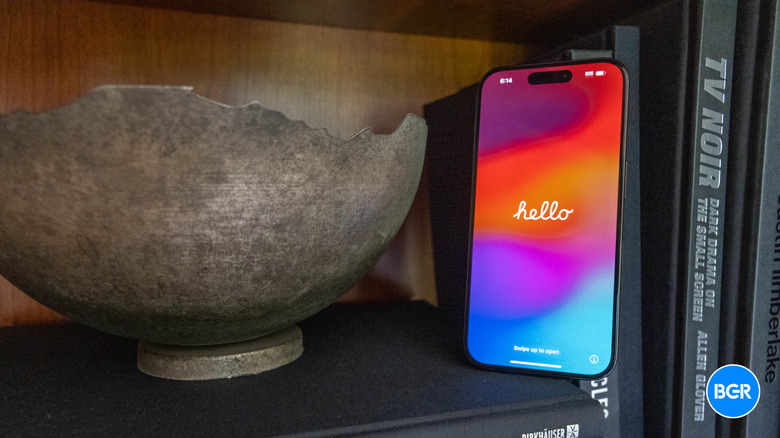iPhone 16 Pro Probably Won't Have A Smaller Dynamic Island, And That's OK
As expected, the new iPhones all feature the same design. Unlike the iPhone 14 models, the four iPhone 15 models all feature the exact same Dynamic Island. This should be an advantage for the base iPhone 15 and 15 Plus, which do look like new phones. Comparatively, the iPhone 14 and 14 Plus felt dated in 2022 alongside the iPhone 14 Pros.
The iPhone 16 and iPhone 16 Pro variants should feature the same design as the iPhone 15 series, with another hiccup. The iPhone 16 Pro and 16 Pro Max could be slightly larger than their predecessors. Add a mysterious Capture button to next year's Pros, and that's about everything we expect from the iPhone 16 Pro models in terms of visible design changes.
As for the rumor going around that Apple is testing a new hole-punch design for the iPhone 16 Pro, I wouldn't expect such a big design update so soon. I'd also say we don't need a Dynamic Island change until Apple is sure it can place Face ID components under the screen. Because that's the only way the hole-punch design comes to the iPhone.
Most Android flagship phones out there feature hole-punch designs. They've used punctured OLED panels for several years. But they've done so because they lack 3D face recognition support, which is a major pillar of the iPhone experience. Android handsets still have a hole-punch display as under-display camera tech has not reached a maturity that vendors would be comfortable with.
I do expect Apple to slowly move to all-screen iPhones. That's the perfect iPhone design. But Apple will take baby steps to get there.
Like keeping the iPhone X notch in place from 2017 through 2022. Then, moving to the pill-shape Dynamic Island and keeping it in place for at least a couple of years. A hole-punch iPhone 17 with Dynamic Island functionality would follow before an all-screen iPhone would be possible.
Well-known display analyst Ross Young painted such a picture. According to his display supply chain information, the iPhone 17 Pros will debut the hole-punch Dynamic Island in 2025. Not next year's iPhone 16 Pros. All iPhone 16 versions should feature Dynamic Island cutouts in the form of a pill, like their predecessors.
Apple is testing a iPhone 16 Pro hole punch version, but it may not be finalized. Details will depend on March next year. I guess most likely we won't see such a version until the iPhone 17 pic.twitter.com/exeo8gWoT0
— Majin Bu (@MajinBuOfficial) November 10, 2023
Leaker Majin Bu said recently that Apple is testing an iPhone 16 Pro variant with a hole-punch display instead of the pill cutout. That's always possible, and I fully expect Apple to do that. But I'd also expect these tests to concern the iPhone 17 series rather than next year's models.
Apple has to start somewhere with the hole-punch approach. It has to test under-display Face ID components to ensure they work. And I think Apple has been testing under-screen Face ID, Touch ID, and camera tech for years. It has patents detailing such innovations that would let it deliver hole-punch displays and perfect all-screen iPhones.
Like I said time and again, Face ID is the key iPhone feature for me. It unlocks the iPhone and all the key apps that require secure authentication. It all happens incredibly fast, and it's the one iPhone feature I can count on to "just work."
I can't envision a better, almost passive authentication system. And I definitely don't want Apple to put Face ID under the screen too early. I want Face ID to continue working as reliably as before once we make the switch to hole-punch displays.
It's not just Apple researching such technology. And if Apple wants to test hole-punch displays, it needs to provide screen vendors the specs for the OLED panels it wants. In turn, OLED screen makers need time to develop production lines that meet Apple's needs.
What I'm saying is that it makes sense to see rumors about Apple testing exciting new features well before they're ready for commercial deployment. As a reminder, rumors said Apple was testing 120Hz panels for the iPhone 12, but Apple brought ProMotion to the iPhone a year later with the iPhone 13 series. So, while this iPhone 16 Pro rumor makes sense, I'd say it's too soon to get too excited about it.
I'll also point out Mark Gurman's recent iOS 18 coverage. The insider has a much better track record at revealing Apple secrets than Majin Bu. Gurman said the iPhone 16 won't have any major hardware upgrades. Apple will use iOS 18's big features to sell the new hardware.
